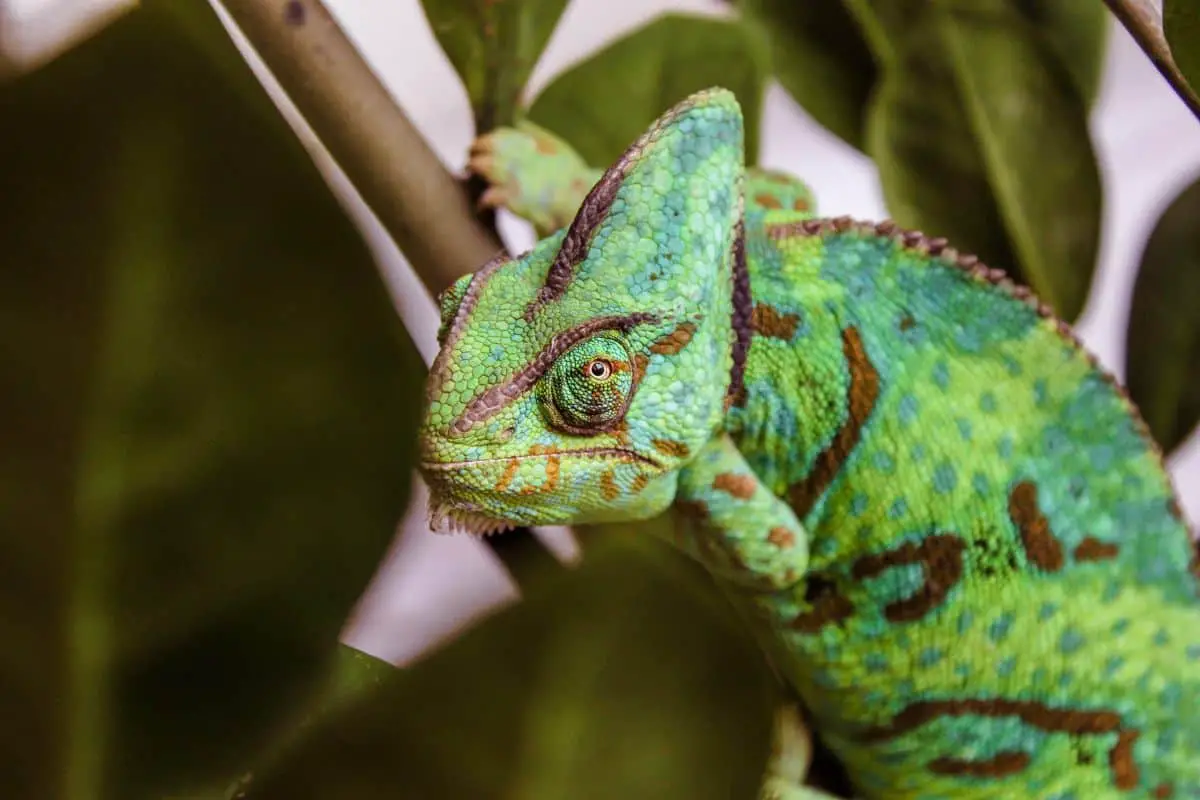How to Clean a Chameleon Cage? 3 Ways to Keep On Track!
Chameleons need their enclosure to be spot cleaned daily by performing the following 5 steps:
- Remove uneaten insects
- Remove feces and urates
- Clean and sanitize any area that came in contact with waste
- Soak up any spills or pooling water from the enclosure
- Give the enclosure and your chameleon a quick glance to make sure your chameleon look healthy and that everything is in working order
Every week the habitat and decorations need to be cleaned and every few months the entire habitat should be cleaned and sanitized.
Reptile Roommate is a participant in the Amazon Services LLC Associates Program. As an Amazon Associate I earn from qualifying purchases.
How Often Do You Need to Clean a Chameleon Cage?
Chameleons can be a bit more responsibility than some other reptiles. Given their need for more attention and a bit more care, cleaning a chameleon’s habitat every day is quick and simple; though their enclosures will need to be more thoroughly cleaned and disinfected at regular intervals.
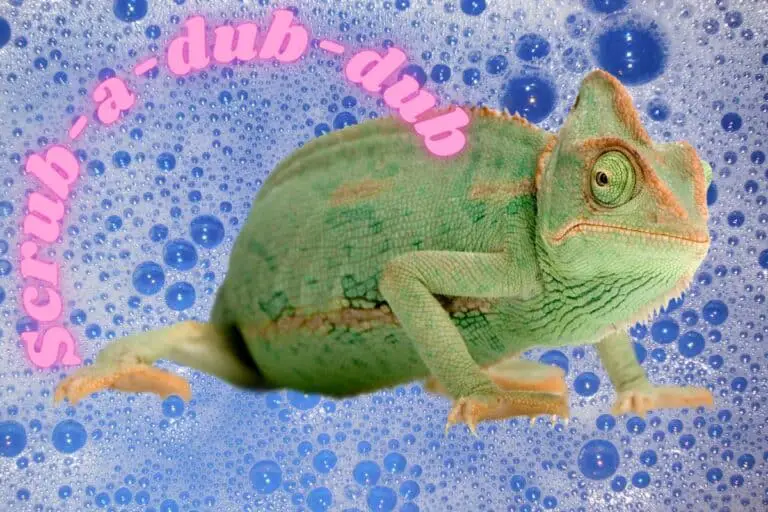
Daily Chameleon Enclosure Cleaning; Spot Cleaning
Chameleon cages should be spot cleaned every day. Chameleon waste, both urate and formed stool, and uneaten food need to be removed and cleaned every day.
Failure to do so can result in bad odor and bacterial growth. Bacteria can thrive in chameleon enclosures due to the warmth and high humidity commonly found in its environment
Supplies needed for daily spot cleaning:
- Paper towels -one of the cheapest and most useful tools in keeping your chameleon enclosure clean are paper towels. You can pick up waste and uneaten food as well as wiping down surfaces that have become soiled. Buying in bulk can be a great idea!
- Cloth/Sponges -damp cloths and sponges are similar to paper towels but can have the added benefit of being more effective in removing dried on stubborn areas in the enclosure.
- Surface Cleaner -a popular reptile safe cleaner is Wipe Out 1 from Zoo Med. You can use a commercial cleaner like this to spray on any areas that waste or dead/decaying insects have been in contact with. A solution of warm water and vinegar can also be used.
You want to use this time to also check on your chameleon and the overall “health” of its enclosure.
10 things to take note of during your daily spot cleaning:
- Chameleon Checkup – Does your chameleon look okay? Do you notice anything different or unusual?
- By the Numbers – Are humidity and temperature levels appropriate?
- Remove Insect parts – Any leftover insect parts, pieces, or dead individuals should be removed and discarded.
- Hide and Seek – Live insects are great at sneaking away and hiding in/under cage decorations and plants, make sure to find them and dispose/refeed.
- Chameleon’s Feeding Dish – Wash and clean your chameleon’s feed dish. (only applies if you use a dish to feed you chameleon)
- Observe Waste – Look at your chameleon’s feces and urate, do they appear normal?
- Creepy Crawlies – Do you see any signs of mites (small dark colored spots on a chameleon’s skin), ticks (somewhat larger than mites, brown, black or gray in color), or internal parasites (usually noticed in the chameleon’s feces)?
- Spot Clean – Wipe up, clean and sanitize any urates or feces in the enclosure.
- Pooling water – Soak up any spills or standing water as this can be a magnet for bacteria.
- A Quick Glance – Give the entire enclosure a quick check and make sure everything is “normal” and in working condition.
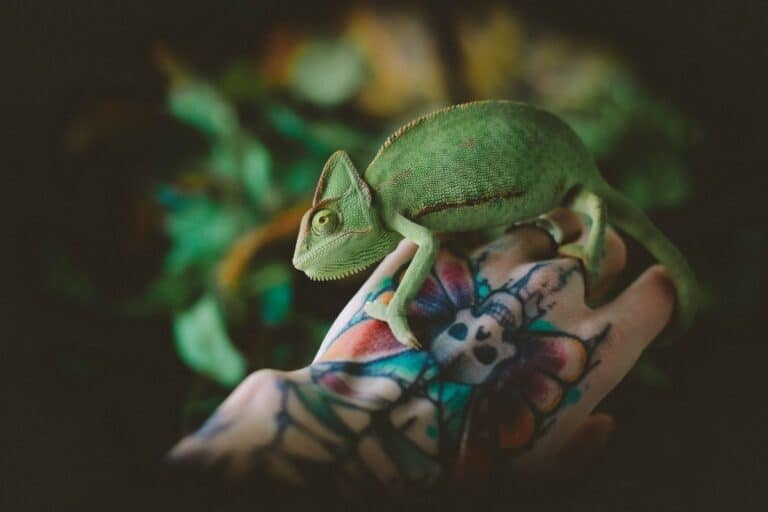
Weekly Chameleon Enclosure Cleaning
Weekly cleanings are similar to what you’ll do during your daily spot cleans except that you will also be sanitizing the enclosure walls, decorations and replacing the substrate (if you use substrate)
Your weekly cleanings will be more thorough and will also include the following:
- Light/Heat Bulbs – Checking and cleaning (if necessary) all bulbs, both for lighting and heating
- Misting System – If your enclosure has a misting system to provide humidity, make sure it functions and is clean
- Probes – Temperature/humidity probes should be checked for damage and cleaned
- Give the Plants a Wipe – Leaves of live plants and any vines, decorations, etc should be cleaned
Depending on your daily spot cleaning habits and your chameleon, you may be able to do bi-weekly cleanings instead of doing them every week, but just don’t let the quality of your husbandry slip as it can lead to bacterial problems and ill health.
Quarterly Chameleon Enclosure Cleaning
Ideally, you would perform this deep cleaning and sanitization every 3 to 4 months however, depending on how clean you keep your chameleon’s enclosure, this may be only necessary every 6 months.
In addition to your daily spot cleaning and weekly cleaning, you will perform a deep clean and sanitize your chameleon’s entire enclosure, all equipment and anything related to your chameleon’s maintenance.
During deep cleaning and sanitization you’ll want to complete the following steps:
- Chameleon Hotel – A temporary enclosure (just for an hour or so) for your chameleon will allow you to take apart, sanitize and service your chameleon’s permanent habitat. The cleaning agents used and sanitization methods require a completely empty enclosure.
- Remove Everything – remove all decorations, live plants and equipment from the enclosure. This includes probes, substrate (if used), dishes, vines, etc.
- Soak – Any synthetic plants or vines, feeding dishes and other equipment should be soaked in warm soapy water.
- Live Plants – live plants should be wiped down and cleaned similar to your weekly cleanings, however now is the time to do so more thoroughly; perhaps even showering them with water outdoors.
- Surface Cleaning – All enclosure surfaces are to be cleaned with warm soapy water. Tough spots or stains can be cleaned with a reptile-safe cleaner and razor blade, scrub brush, etc. You can also use a 10% bleach solution for cleaning.
- The Rinse – After cleaning all enclosure surfaces and accessories with soap and water, rinse THOROUGHLY.
- Disinfecting – After all surfaces, decorations and supplies have been washed and thoroughly rinsed with clean water, you will disinfect them with a reptile-safe disinfectant such as Wipe Out by ZooMed.
- Let It Dry – Make sure that you let everything dry after disinfecting before you begin to reassemble your chameleon’s enclosure.
- Re-Build – Assemble the enclosure and reintroduce your reptile friend back into its habitat!
- The Aftermath – Don’t neglect to disinfect all supplies like buckets, your temporary cage and your sink, etc. Make sure you wash and sanitize your hands with antibacterial soap!
Tip: | Many chameleon keepers, and reptile keepers in general, utilize a steam cleaner to sanitize and disinfect their various enclosures, habitats, and equipment.
Steam cleaners are great because they don’t use chemicals and the high heat is sure to destroy even the most bacteria and other nasties!
A large sized steamer is recommended as smaller units may not generate enough steam to properly disinfect.
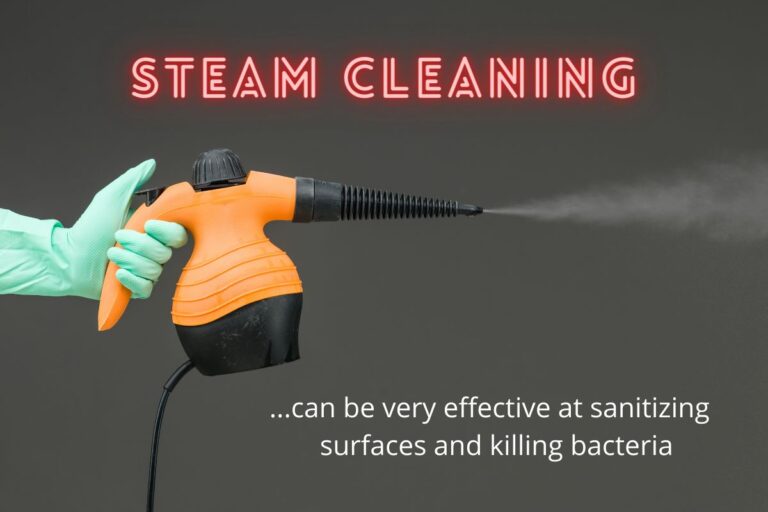
What Do You Use to Clean a Chameleon Cage?
You’ll use several products while cleaning your chameleon’s enclosure. Here’s a handy Chameleon Cleaning Checklist:
- Paper towels / Cloth
- Soap (dawn dish soap works great)
- Bleach or vinegar (to make a diluted cleaning solution)
- Disinfectant such as Wipe Out
- Antibacterial soap
- Secondary (temporary) enclosure
- Bucket(s)
- Razor blades/scraper/toothbrush
- Industrial steamer
How Often Do Chameleons Poop? How to Clean Chameleon Poop
Juvenile chameleons will defecate nearly every day, while adult chameleons can go once every 5 to 7 days on average.
Chameleons tend to relieve themselves in a designated area of their enclosure (although not always the case) which allows you to observe and spot clean when necessary.
Feces vs Urates
A chameleon produces two types of waste products, feces and urates. Fecal matter is what we normally think of as animal waste/poop which can be brown to almost black in color and actually has relatively little odor.
Urates are a more solid form of urine resulting from a reptiles efficient usage of water. Reptiles retain much of the water they consume and so instead of urinating they produce a soft white substance called urates.
Chameleon bowel movements will often contain both feces and urates. Some bowel movements will be feces with a urate “cap” on top and others can be ‘separate pieces’ of feces and urate.
This is a (obscured until the picture is clicked on) picture of a normal chameleon bowel movement showing both feces and urate.
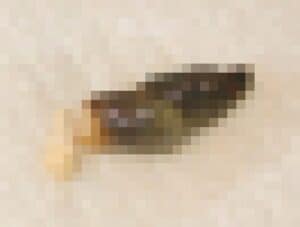
Is Dawn Dish Soap Safe for Reptiles?
Dish soap tends to be a mild surfactant that many use to clean reptile enclosures and decorations.
Soap should be thoroughly rinsed from any surface that your chameleon will come in contact with.
NEVER use dish soap (or any other soap) directly on your chameleon!
How to Clean a Reptile Tank with Vinegar (Acetic Acid)
Vinegar can be used full strength or in a 50/50 solution with warm water as a means to clean and help disinfect your chameleons enclosure and equipment.
Vinegar can be especially helpful in cleaning glass.
However, vinegar does not adequately disinfect, or kill all harmful bacteria, germs and parasites.
Disinfecting with a bleach solution, reptile-safe disinfectant or steam cleaning is necessary for optimal health.
Can You Take a Chameleon Out of Its Cage to Clean It?
While doing your daily spot cleaning it isn’t necessary to remove or “bother” your chameleon in any way; you can quickly clean up waste and uneaten food without disturbing your chameleon much at all!
Your weekly cleaning chores, depending on the needs of your particular enclosure, may necessitate your chameleons removal from the habitat in order to perform the maintenance.
This however should not take very much time and temporarily housing your chameleon shouldn’t pose much of an issue.
Quarterly cleanings on the other hand, will require temporary housing for your chameleon because of the need to remove all items from the enclosure, the time it takes to perform the cleaning, and the use of cleaning products/techniques to ensure proper disinfection of teh habitat.
Chameleon Cage Setup
A chameleon’s enclosure needs to provide ample area for your chameleon to climb and regulate its body temperature.
While specific enclosure setup is beyond the scope of this article, it is important to keep in mind how you’ll clean and disinfect the habitat while setting it up!
You’ll want to utilize sturdy, durable vines, decorations, and plants that can be wiped off, washed and can withstand a bit of handling and cleaning.
If your enclosure has glass sides or panels you’ll want to make sure to have some razor blades or other scraping tools handy to keep the glass clean.
Since a chameleon’s enclosure tends to be humid and may be repeatedly sprayed with moisture, the bottom of its enclosure and substrate (or lack of one) also needs to be carefully considered.
What to Put on the Bottom of a Chameleon Cage?
The issue of substrate in chameleon enclosures can spark up a heated debate. However, I’m of the opinion that simple = best!
Bare bottom enclosures seem to be the simplest and best solution to the chameleon enclosure substrate question.
A bare bottom allows for simple clean up using paper towels or cleaning cloths and does require purchasing materials or supplies that need to be changed.
One addition to a bare-bottomed enclosure would be a mesh or screen layer just above the floor to allow moisture and water to drain away and eliminate contact between it and your chameleon.
Some chameleon keepers use paper towels or newsprint to line the enclosure bottom; replacing the layers as needed when they become soiled. This layer should also have a barrier between your chameleon’s “living space” so that your chameleon can’t come into contact with soiled towels or paper.
Some substrates that should be avoided altogether are soil, mosses and orchid bark. Not only will these substrates become soiled and will need to be replaced which can get expensive, they are also prime real estate for bacteria, germs and mold.
Tip: | Plants do not need to be planted in an enclosure’s substrate layer. Plants such as ficus that are used in your chameleon enclosure should be kept in its pot and the soil can be covered with small pebbles or stones to “seal” the dirt layer.
Do Chameleons Smell?
Chameleons generally do not have an odor or smell bad. However, that does not mean that your chameleon’s enclosure won’t smell; and if it does it’s probably our fault as keepers!
A chameleon habitat can smell bad or have an odor for a number of reasons, most of which are directly related to husbandry and one or two depending on what we feed.
Poor husbandry and neglecting to spot clean every day and failing to keep up with you regular interval cleanings will lead to odor and foul smells coming from your chameleon’s enclosure.
There is no cheating when it comes to cleaning! The number one reason for a bad smelling enclosure is failure to clean up chameleon waste in a timely manner.
Waste needs to be physically removed and the area also cleaned and sanitized so that bacteria doesn’t develop.
More thorough habitat cleaning and maintenance, both weekly and quarterly cleanings, are also needed to ensure that bacteria and odor causing mold and mildew are kept at bay.
Feeding your chameleon a steady diet of crickets is another sure way to develop a habitat that smells bad. Crickets, especially if you are raising a colony of your own, stink!! (they’re also super noisey)
The only time that your chameleon itself would smell bad or give off an odor may suggest potential parasites or mouth / tail rot. These conditions require veterinary intervention.
Should I Give My Chameleon a Bath?
Chameleons do not need to be bathed except by the direction of your veterinarian. A veterinarian may advise baths for severely dehydrated individuals but this determination should be made by a medical professional.
Showering, which some people confuse with bathing (or even with how people shower) can be used as a way to hydrate your chameleon and assist with shedding.
However, showering is used as a method to bathe your chameleon where water is showered over its head and body; rather a light mist (shower) of water can be sprayed adjacent to your chameleon providing an indirect sprinkling of water.
It’s more an effort to mimic rainfall than an actual shower.
Your chameleon may use this opportunity to drink some of the water as it gathers and drips from its body or enclosure. Just remember that this “shower’ isn’t the same kind as you take in the morning after your cup of coffee!
How to Clean a Chameleon Cage (Enclosure) Conclusion
Keeping your chameleon cage clean depends on you! Chameleons don’t need to be bathed or washed but their enclosures and habitats definitely do!
The regular cleaning, disinfecting and maintenance will definitely benefit you and your chameleon’s health!

